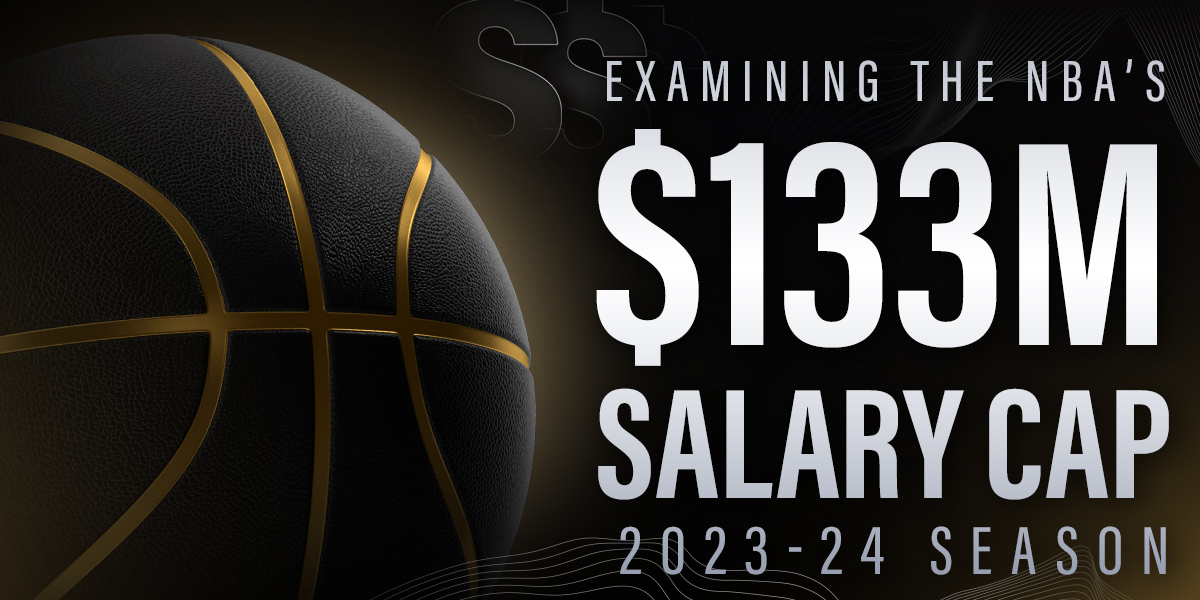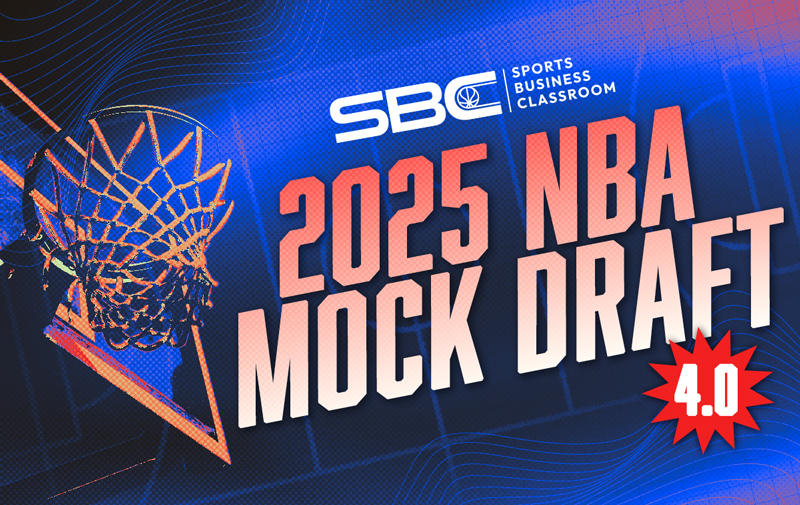
The NBA announced its salary cap figures for the 2022-23 season, along with a new projection for the 2023-24 campaign at $133 million with a luxury tax threshold of $161 million.
By December 15, 2022, the NBA and National Basketball Players Association can opt out of the current collective bargaining agreement. A new deal could lead to a system change that alters the landscape of the league. Or it could be very much like the current system.
Based on the rules in place, the climb in salary cap from $123.7 million to $133 million would have the following impact on the 2023-24 season, starting with maximum salaries (based on the players’ years of service in the league):
| YOS |
2022-23 | 2023-24 |
| 0-6 | $30,913,750 | $33,250,000 |
| 7-9 | $37,096,500 | $39,900,000 |
| 10+ | $43,279,250 | $46,550,000 |
Minimum salaries would similarly climb:
| YOS |
2022-23 | 2023-24 |
| 0 | $1,017,781 | $1,094,698 |
| 1 | $1,637,966 | $1,761,752 |
| 2 | $1,836,090 | $1,974,849 |
| 3 | $1,902,133 | $2,045,883 |
| 4 | $1,968,175 | $2,116,916 |
| 5 | $2,133,278 | $2,294,497 |
| 6 | $2,298,385 | $2,472,081 |
| 7 | $2,463,490 | $2,649,664 |
| 8 | $2,628,597 | $2,827,248 |
| 9 | $2,641,682 | $2,841,322 |
| 10+ | $2,905,851 | $3,125,455 |
Note: the NBA reimburses teams for the amount over the two YOS veteran minimum, provided the contract is a one-year minimum deal. In those cases, the player will count against the cap at the two YOS minimum, which would also be their outgoing salary in trade.
The following exceptions will also climb with the cap:
| Exception | 2022-23 | 2023-24 |
| Non-Taxpayer Mid-Level | $10,490,000 | $11,283,000 |
| Taxpayer Mid-Level | $6,479,000 | $6,969,000 |
| Room Mid-Level | $5,401,000 | $5,809,000 |
| Bi-Annual | $4,105,000 | $4,415,000 |
Teams below the salary cap will have access to just the Room Mid-Level Exception (RMLE). Those who do not drop under the salary cap but stay below the NBA’s hard cap (or apron) can use the Non-Taxpayer Mid-Level (NTMLE) and Bi-Annual (BAE) Exceptions. Tax teams above the apron will only have the Taxpayer Mid-Level (TMLE)
With a luxury tax projection at $161 million, the apron (hard cap) projects to reach $167,971,000. At 90 percent of the cap, the minimum team salary would be $119,700,000.
Additionally, rookie-scale contracts (for the top-30 draft picks in June) will climb proportionately. The scale amount for the No. 1 pick would be $9,908,800, though it’s nearly a standard for players drafted in the first round to earn the maximum 120 percent of scale. The following table shows the projected rookie-scale salaries (at 120 percent) for the 2023 draft class:
| Pick | 2023-24 | 2024-25 | 2025-26 | 2026-27 | Proj. Qualifying Offer |
| 1 | $11,890,560 | $12,485,280 | $13,079,880 | $16,493,729 | $21,441,848 |
| 2 | $10,638,720 | $11,170,920 | $11,702,880 | $14,769,035 | $19,273,591 |
| 3 | $9,553,920 | $10,031,400 | $10,509,240 | $13,283,679 | $17,428,187 |
| 4 | $8,613,720 | $9,044,520 | $9,475,320 | $11,986,280 | $15,809,903 |
| 5 | $7,800,240 | $8,189,880 | $8,580,120 | $10,871,012 | $14,414,962 |
| 6 | $7,084,560 | $7,438,800 | $7,793,280 | $9,881,879 | $13,182,427 |
| 7 | $6,467,400 | $6,790,920 | $7,113,960 | $9,034,729 | $12,115,572 |
| 8 | $5,924,880 | $6,221,280 | $6,517,440 | $8,290,184 | $11,175,168 |
| 9 | $5,446,200 | $5,718,720 | $5,991,000 | $7,632,534 | $10,342,084 |
| 10 | $5,173,800 | $5,432,520 | $5,691,000 | $7,256,025 | $9,882,706 |
| 11 | $4,915,200 | $5,161,080 | $5,406,960 | $7,175,036 | $9,822,624 |
| 12 | $4,669,560 | $4,903,200 | $5,136,720 | $7,078,400 | $9,739,878 |
| 13 | $4,435,920 | $4,657,920 | $4,879,680 | $6,973,063 | $9,643,746 |
| 14 | $4,214,520 | $4,425,120 | $4,636,080 | $6,866,034 | $9,550,653 |
| 15 | $4,003,320 | $4,203,480 | $4,403,640 | $6,750,780 | $9,437,590 |
| 16 | $3,803,400 | $3,993,480 | $4,183,920 | $6,418,133 | $9,017,477 |
| 17 | $3,613,080 | $3,793,680 | $3,974,400 | $6,104,678 | $8,619,805 |
| 18 | $3,432,600 | $3,603,960 | $3,775,800 | $5,807,180 | $8,240,388 |
| 19 | $3,277,920 | $3,441,720 | $3,606,000 | $5,553,240 | $7,918,920 |
| 20 | $3,146,640 | $3,304,080 | $3,461,160 | $5,337,109 | $7,648,077 |
| 21 | $3,020,880 | $3,171,960 | $3,323,160 | $5,293,794 | $7,628,357 |
| 22 | $2,900,160 | $3,045,120 | $3,190,080 | $5,247,682 | $7,598,644 |
| 23 | $2,784,240 | $2,923,560 | $3,062,400 | $5,196,893 | $7,561,479 |
| 24 | $2,673,000 | $2,806,560 | $2,940,360 | $5,142,690 | $7,518,613 |
| 25 | $2,565,720 | $2,694,240 | $2,822,640 | $5,083,575 | $7,467,772 |
| 26 | $2,480,880 | $2,604,840 | $2,728,800 | $4,920,026 | $7,261,958 |
| 27 | $2,409,240 | $2,529,600 | $2,650,320 | $4,781,177 | $7,090,485 |
| 28 | $2,394,240 | $2,514,480 | $2,633,760 | $4,753,937 | $7,083,366 |
| 29 | $2,377,080 | $2,495,760 | $2,614,800 | $4,719,714 | $7,079,571 |
| 30 | $2,359,800 | $2,477,760 | $2,595,960 | $4,685,708 | $7,028,562 |
Additionally, the amount of cash that teams can use in trade projects to climb from the current figure of $6,363,000. A franchise will be able to send out as much as $6,844,000 from July 2023 to June 30, 2024. A team can also receive the same amount via trade, regardless of how much it sends out throughout the 2023-24 season.





